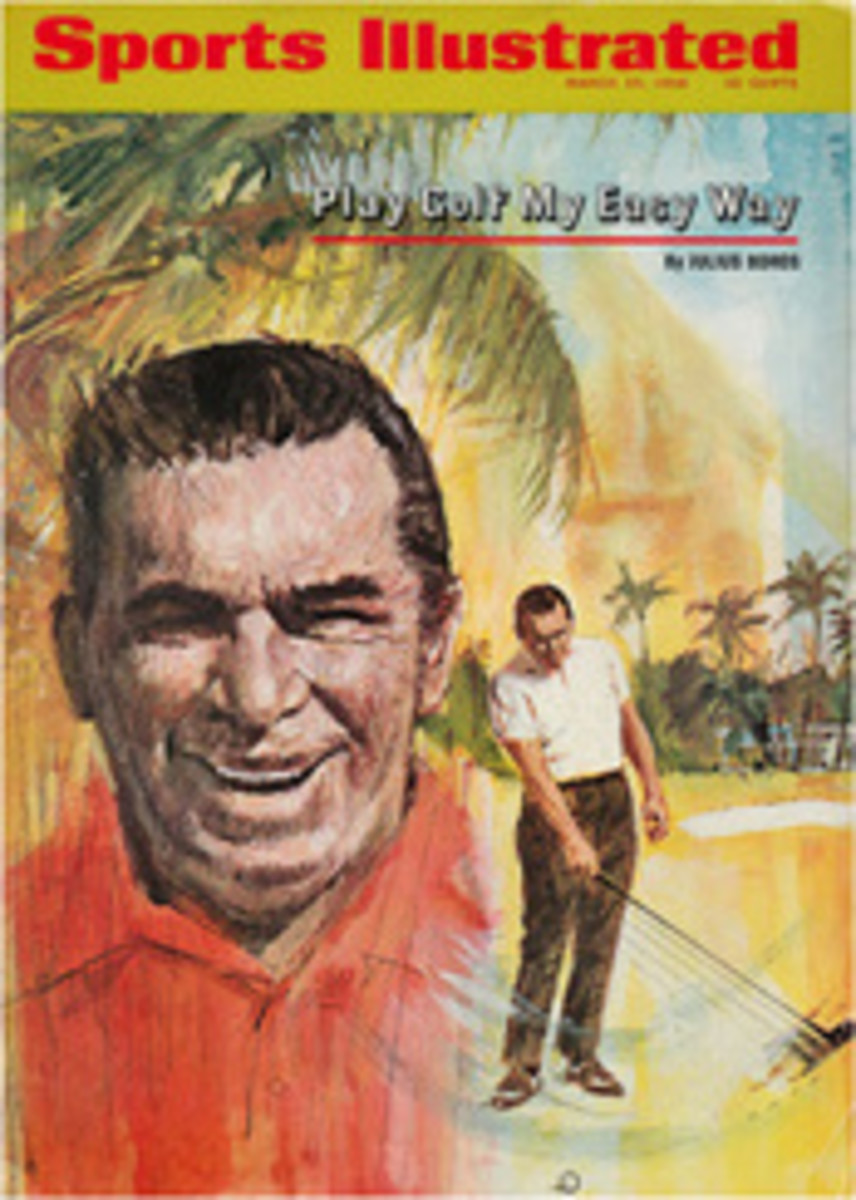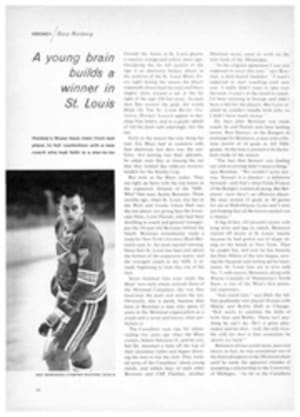
My Easygoing Game
Play a round of golf with me and I hope you will relax and enjoy yourself. That's what I plan to do. People worry so much about their games. You can see them out there on any weekend, fidgeting over every shot as if the U.S. Open depended on it. Wind direction, downhill lie, trapped green—is this the right club, maybe a six-iron would have been better, spread the stance a little wider, recheck the grip...endless worry. You should think about these things, certainly, but not while you're addressing the ball. If you haven't figured out what club to use by the time you have addressed the ball, you might as well forget it, because the delay while you hover over that little white ball is only going to hurt your game. Besides, what if you do knock it into the trap? Your life doesn't depend on it. Not even your living.
Now, mine does, but when I find that playing golf is work and that I'm beginning to worry about it I'll switch to something else. No game is worth the agony that some golfers go through, and that includes a few of my fellow pros on the tour. How many times have you played with someone who has missed a shot, lost his temper and, because of it, missed the next shot, too. There is nothing sillier than this. You know when you leave the clubhouse and head for the first tee that you are going to hit a certain number of bad shots, so learn to accept them. I have. Next time you hear somebody say, "That Julius Boros looks so relaxed out there," you'll know it's because I am relaxed.
Of course, feeling relaxed and looking relaxed are not necessarily the same thing. The reason I look so casual is because of my swing. I know the jokes: "He's so relaxed he falls asleep on his backswing." People ask me how I keep my cool out there on the tour, especially in a difficult situation. The answer is that I'm a swinger—and I mean that in the golfing sense—not a hitter. There's a difference. A swing is a slow, fluid motion. A hit is fast, abrupt and muscular. Palmer and Nicklaus are hitters. They can afford to be hitters because they are strong enough and play often enough to maintain a routine mechanical coordination. Now you do not play every day, maybe not even every week, so why should you be a hitter? Me? I'm the oldest pro regularly on the tour, but if I tried to muscle the ball the way Palmer and Nicklaus do I'd be home in Fort Lauderdale most of the year. Consider this: you swing the golf club anywhere from 34 to 50 times a round, discounting putts, of course. It would be impossible to repeat a fast, jerky, muscular movement every time. Sure, you might hit a few good shots in a row, but soon your timing would fall apart. Maybe this has happened to you now and then, and you've never understood why you started to fold along about the back nine. Perhaps sooner. A relaxed swing such as mine requires very little physical strain and is, in fact, very easy to repeat throughout the round. The swing I use in a practice round on Tuesday is exactly the same as the one I use in the final round on Sunday. I know that the big hitters cannot say the same thing.
The process of executing this swing should not be involved either. You have a club in your hand and you must hit the ball to a target. The time to plan your shots is as you walk to the ball, either on the tee or in the fairway; what club to hit, where to hit, how far to hit it, how to hit it, etc. Make your first impression about the shot be your last one. Do not waver at all—or else you are likely to miss the shot. One thing you'll never see me do is take a practice swing. The biggest waste of time in golf, I think, is to swing at an imaginary golf ball. So, rather than use up energy with practice swings, I simply take the club in my right hand and practice a release—moving my hands and body the way I will when I hit the ball in a few more seconds. Then I set up, always managing to keep something in motion—my hands, my shoulders, my hips—so that I can remain loose. I keep my feet together and the club head behind and slightly above the ball, not letting it come to rest until the instant before I start my backswing. Then I spread my feet, lining them up in the direction of my target. Now comes the swing, slow and easy, started by my shoulders. I move down into the ball with the same rhythm. In the last 12 inches before impact I release strongly into the ball and then continue through it and complete my swing. The ball has been hit and there is nothing more I can do about it, so I start walking to it—thinking all the time about the next shot. There was no indecision. No wasted motion. No strong-arm tactics. Only an easy, fluid motion. This is the secret of my game.
The essence of Julius Boros' game is the speed and ease with which he hits his shots. Forgoing practice swings, Boros waggles the club in his right hand, addresses the ball, spreads his feet, swings and walks on down the fairway.
The simplest way to play golf is to swing with your shoulders. This is a theory I learned as a boy, and I have stayed with it ever since. Modern schools of golf instruction teach the hip theory; that is, move the hips back first, follow with your shoulders and then turn in your left knee. That's three separate moves and, therefore, the chance for three separate mistakes. The shoulder theory, however, is uncomplicated. First of all, just think about moving your left shoulder. If you move your left shoulder then your right shoulder is going to move, too. So forget about the right completely. Now take a club in your hand and stand as if you were addressing the ball. Bring the club back with your left shoulder (left), turning the point of the shoulder toward and then away from the golf ball. Notice that this movement automatically causes your hips to turn and your left knee to bend in exactly as it is supposed to do. There you are, three distinct moves executed naturally, without any wasted effort or worry. Now, when I want to hook or fade a shot, I make a slight adjustment in the position of my left-shoulder during the backswing. To fade (above left), I move my left shoulder down during the backswing so the right stays below during the downswing. This delays my hands at impact enough so the ball will work to the right. To hook (right), I turn the left shoulder abruptly inside—keeping both shoulders parallel with the ground throughout the swing. This forces my hands to sweep across the ball and turn over at impact—causing a hook.
Unlike most golfers, I use two grips, switching whenever one feels uncomfortable. Most of the time I use the overlapping grip (far right), but I'm not a slave to it, and if it doesn't feel right I'll change, even in mid-round, to the interlocking grip, which steadies my left hand.
When the ball sits well in the trap (above), set your feet firmly, but not deeply, and swing at an imaginary target about the width of half a ball behind the real ball.
For buried shots, dig your feet into the sand so they will not move at impact and aim at an imaginary target the width of at least a ball and a half behind the real ball.
Don't panic when you hit your ball into a sand trap. Getting it out isn't all that difficult. The first thing I recommend, obvious as it may seem, is the sand wedge. Many weekend golfers try to blast out of traps with a pitching wedge, but a sand wedge, with the big flange that gives the club plenty of bounce and the wide open face, will make the shot easier.
Perhaps the most difficult aspect of sand play for the weekend golfer is knowing how much sand to take when you hit the ball. Essentially, it is a matter of practice, but these guidelines should help. If the ball is in a clean lie, imagine there is half a golf ball directly behind yours and hit "that ball" in a normal fashion. If your ball is buried, hit a ball and a half's distance behind, or slightly more. Practice will give you an instinct for it.
At address, you should open the face of your club. After impact, you must keep your left hand moving through the ball (right), despite the resistance of the sand. Finally, never let your right hand cross over your left. If you do you will bury the club head and never get the ball into the air.
ILLUSTRATION
FRANCIS GOLDEN
EIGHT ILLUSTRATIONS

